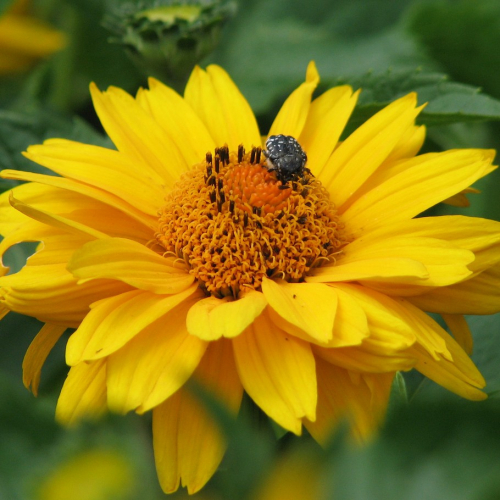Perennials Heliopsis

Description
Special Features of Heliopsis
Heliopsis or Sungrass is a genus of annual and perennial plants belonging to the family Asteraceae or Compositae. Native to America, Heliopsis is also successfully cultivated and requires minimum care. In the wild, this genus can be found in the fields, on the edges or along the roads. Its flower resembled a bright little sun, for which it received its beautiful name that translates from Greek as "similar to the sun". In Germany, this plant is called Sonnenauge, which means "eye of the sun."
Heliopsis grows 70 to 160 cm tall. The stems are branched, and the leaves are opposite or alternate, bright green, and toothed. The flowers (up to 10 cm in diameter) are golden, orange, or brownish and collected in panicles. There are varieties with double, semi-double, and simple flowers. Flowering occurs from mid-June until late autumn. The fruit is a flat achenes. To a quick eye, the plant looks similar to "Golden Ball" plant, but a closer look shows significant differences in the structure of leaves and inflorescences.
The genus of Heliopsis has about 10 species. Only one species (Heliopsis helianthoides) is cultivated. Heliopsis helianthoides has straight stems reaching a height of one meter, oval leaves, and golden flowers blooming in late June. This species has a widely spread varieties, Heliopsis helianthoides var. Scabra. Some scientists consider it to be a separate species.
Heliopsis helianthoides var. Scabra grows to 150 cm tall, has rough stems and leaves and bright yellow or orange flowers. Thanks to the fruitful selection works, currently you can find many different varieties in the gardens: ‘Goldgrenherz' (lemon ray flowers and emerald tubular flowers), ‘Daueigold' (yellow heads about 12 cm in diameter), ‘Sommersonne' (semi-double golden flowers that blooms in late July), ‘Neue Hybriden'(lemon ray flowers and yellow brown tubular flowers), ‘Spitzentenzerin'(orange flowers), ‘Golden Plume' (double golden flowers), ‘Loraine Sunshine' (variegated leaves), ‘Summer Nigth' (purple stems, bronze leaves, and yellow flowers), ‘Ballerina' (only about half a meter tall), ‘Asahi' (small double flowers without a core), ‘Summer Pink' (variegated pinkish leaves ), ‘Sun Shield' (double flowers with curved petals), ‘Mars' (middle-sized semi-double orange flowers).
Yellow and orange colours have a positive effect on physical and mental condition of a human, so Sungrass is not only beautiful, but also useful plant. Moreover, it can be used in various arrangements. The garden Heliopsis is perfect in mixed borders, solitary plantings near fences or walls. The best companions are various perennials with blue or purple flowers, such as Asters, Cornflowers, Bluebells, and Delphiniums. Marigolds, Herbs, Rudbeckia, Echinacea, Tickseed, Aconite and Phlox will also look good. In addition, Sungrass is perfect for cutting, since it has a fairly long vase life.
The Secrets to Successfully Growing Heliopsis
Sungrass requires minimum care and can be recommended for beginners. The plant likes open sunny areas with fertile soil (preferably loam) and good drainage. The basic care for Heliopsis includes moderate watering in hot weather, weeding, soil loosening, deadheading to prolong flowering and staking tall varieties. In the spring and autumn, you might want to use complex fertilizers. In the winter, cut off and spud. Heliopsis is quite hardy and does not need special winter sheltering. Frequent replanting is also not required as Sungrass can grow for about ten years in one place. However, this plant grows very rapidly, so regularly cut out part of shoots with roots.
Heliopsis is propagated by seed, dividing the shrub, and rhizome segments.
Seeds are sown in the open ground before winter or in April - May. Alternatively, you can sow the seeds in February - March for seedlings. The container should have a good drainage. Fill the container with a mixture of humus, peat, and sand. Water the soil with a potassium permanganate solution, sow the seeds on the surface and cover with plastic or glass container. Throughout the week, maintain a temperature of about 20 ° C, and then for 2-4 weeks keep the container in a cool room with a temperature of 3-5 ° C. Seedlings should be regularly watered and ventilated.Keep the temperature of 25-30 ° C. After leaves appear, remove the glass or PE film, prick the seedlings, and keep at a room temperature of 10-15 ° C. When the threat of spring frost has passed (usually in May and June), the young plants can be planted in the open ground in a permanent location. Flowering occurs in the second year.
The shrub can be divided in the autumn or spring (preferably), and it is better to do it as often as every five years, because shrubs gradually become less attractive. Dig up the shrub, carefully divide it into parts. Each part should contain at least one bud. Plant the parts in the prepared soil spacing them 30-50 cm apart.
Potential Problems
Heliopsis rarely gets sick or damaged by pests. Only a few varieties may be affected by rust (a sign of the disease is the appearance of brown spots on the leaves) and powdery mildew (leaves are covered by white grey patina). To prevent fungal diseases, treat the plants with soil fundazol or copper sulfate in the spring and autumn. Then nothing will stop you on your way to a beautiful sunny garden.







 7 750
7 750







